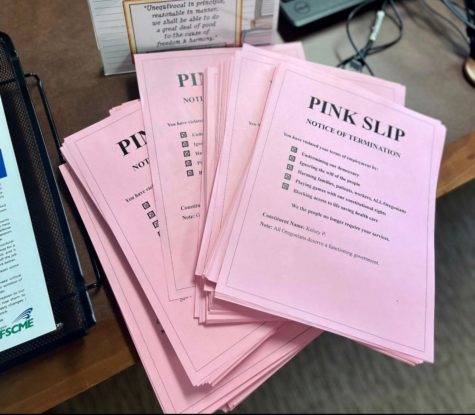What we know about the reduction in force
Pt. 1: What the district has been addressing
Union members rally inside the May 22 school board meeting.
June 7, 2023
What is happening?
On May 22, the Tigard-Tualatin Board meeting continued through a demonstration for the Tigard-Tualatin Education Association (TTEA), calling to “Save the 19”, referring to the 19 declared positions lost due to the Reduction in Force. The Kalapuya Learning Center was full of staff from the district, wearing red shirts and holding various signs opposing the Reduction in Force. Although the demonstration had moved outside shortly before Superintendent Reike-Smith’s remarks, the conversation that followed provided much-needed clarification of the process of the reduction. Here’s a summary of what we have learned and gathered about the whole situation.
Where did the 19 come from?
TTSD made the RIF decision due to projected funds from enrolled students, as well as projected funding from the State budget. The initial senate projection for the state school fund was 9.9 billion dollars, which was 0.3 billion dollars short of desired levels. This caused panic and led to massive RIFs across the state in major school districts such as Beaverton School District, Portland Public School District and the Tigard-Tualatin School District.
TTSD made the decision to make up the deficit in funding by returning to “pre-pandemic classroom sizes”, which would evaluate classroom sizings and “right-size” class rosters, increasing the number of students per classroom. According to Public School Review, Oregon currently has a 19:1 ratio between students and staff members. The average classroom sizes in TTSD have been historically lower than neighboring districts in the state. In a board meeting, Rieke-Smith shared what this meant.
“Based on the number of the students we are serving, [we look at the number] staff members we need to serve the students in [a] variety of areas from K-12, 6-8, and 9-12. Once you have that number you adjust the staffing based on the number of students […] instead when the number came out to 9.9, we realized we needed to not only adjust the number of individuals that we had, but we had to return to pre-pandemic levels,” said Rieke-Smith.
In the Tigard Tualatin Educators Association (TTEA) contract and the Oregon School Employee Association (OSEA) contract, there is an article that dictates the timeline of a RIF to match enrollment. The contract language states that staff in danger of losing their jobs, have to be notified 60 days before the deadline. The district had chosen the deadline of June 30 in order to give teachers the summer to relocate and find other jobs, however that had led to the deadline for notifying RIFed staff on April 28. However teachers can be given their positions back to them after April 30 if circumstances change. Human Resources Director Debbie Ebert elaborated on the process during the May 22 Board meeting.
“In the state law there is a 60 day rule around RIFs, so we have to pick a date when we reduce our workforce. We picked June 30 […] the 60 day rule is often frustrating in a RIF process because we knew that other resignations and retirements would come in that 60 day window, and they’re still trickling in. But there’s nothing we can do about the 60 days. So we had to let people know by April 28,” shared Ebert.
As far as how the decisions were made about who is going to be reduced, many factors played into it.These included full time employee (FTE) allocation, examining contract language, and seniority. Tigard High principal, Brian Bailey, explained this in an interview with The Paw.
They have processes in the contract to determine who has the least amount of seniority and there’s other guidelines and other rules that play into it to determine who is going to be RIFED. — Brian Bailey
Rieke-Smith states, “Then it’s a matter of, all right, it’s a seniority based issue. So then you start looking at seniority, and then individuals that have the smallest and lowest [student] numbers, […] and then you look at where you need to reduce in the building. How many positions do I have open based on seniority? And you are also taking a look at the staff and how they are endorsed, teaching content and any other merit considerations you need to take into play. Then at the end of that, you see all that is left over. You still have transfers to go through […] At the end of all of that, we get the 19.”
How did the district Save 11?
As the debate around the state school fund continued, there was the possibility of more funding coming into each school district to boost the overall revenue. During the May 22 Board Meeting the finalized State School Fund was announced by Representative Bowman, which had established a historic 10.2 billion dollar fund for schools. The increase in potential funding had played a role in deciding staff call-backs.
School Board Member Crystal Weston opens her staff report by saying, “The state budget may improve but it is important for everyone to stay focused on full resources for education for this generation of young people.”
Another factor that went into staff callbacks was incoming resignations and retirements from current teachers. As those positions had reopened, it had provided a path to recall back staff lost from the RIF list. This particular action had saved 11 out of the 19 positions.
Superintendent Rieke-Smith states, “We still have eight to go and that will be an ongoing process, but that’s a commitment articulated in their contracts and that’s a commitment we would make either way. But it’s not a haphazard situation, it is one that is dictated first and foremost by law.”
The district and superintendent reiterate the importance of state law within the RIF process, and the lack of “humanity” and human-centeredness within the laws. The consequences of these state laws are often left to district staff and administrators to handle, which can lead to extremely difficult decisions. However due to the lack of communication and transparency about the allocation of legal power, many staff and students have been unaware of the legality.
Resources to stay informed
Budget FAQ (Created by district)
















